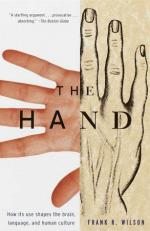
|
| Name: _________________________ | Period: ___________________ |
This test consists of 5 short answer questions, 10 short essay questions, and 1 (of 3) essay topics.
Short Answer Questions
1. What is Jack restoring?
2. What is a "laterality quotient"?
3. What is BachTur?
4. What does Wilson say is an emotional experience?
5. What does Wilson say is not genetic?
Short Essay Questions
1. What area of the brain seems to be specialized for language and for how long has this are been adapted for language?
2. What does Wilson say about the skills of musical virtuosos?
3. What two brain task does Noam Chomsky say are necessary for an individual to speak a language?
4. Explain the term "BackTur."
5. Why does Wilson bring up his friend Jack Schaefer?
6. Explain the studies that are conducted by a joint effort of University of New Mexico and Gallaudet University?
7. What does Wilson say about stone knapping?
8. What is the title of Feldenkrais' book and what does the book claim?
9. What do medicine and magic have in common?
10. What must chefs do to create a meal?
Essay Topics
Write an essay for ONE of the following topics:
Essay Topic 1
Anatomically, ape and human hands have been, until recently, considered functionally equivalent by anthropologists. The prehuman arm, however, was considered functionally and anatomically different metaphorically by analysis to a construction crane and its operator.
1. Explain the metaphor of the prehuman being related to a crane. Use examples from the text to support your answer.
2. Explain what part of the body is the crane operator in the above metaphor and how it relates to the use of the hand. Use examples from the text to support your answer.
3. Discuss the following statement in relation to modern human society. When the forelimbs were relieved of the duty to walk on and support body weight, the brain enabled them to become functional in many other areas and skills. Use examples from the text to support your answer.
Essay Topic 2
Chose one of the following:
1. The hand has been used through its long history for both social interaction and attention. Discuss, in depth, how hands are used for social interaction. Use examples from the text to support your answer.
2. Discuss in depth, some of the ways in which the hand is used for getting attention. Use examples from the text to support your answer.
3. Social pressures often dictate which hand is dominant or most frequently used, such as right or left handedness, and attribute to it other irrelevant characteristics like intelligence or sex. Why do you think people connect unrelated characteristics with which hand is dominant? Use examples from the text to support your answer.
Essay Topic 3
Donald assumes speech is a primary enabler and the outcome of evolution in 1) cognitive capacity as representational or mimetic, 2) articulating speech, and 3) neural structure. Donald summarizes his ideas with the claim that humans did not simply grow larger brains, memories and speaking equipment but rather incorporated new ways to represent reality in their bigger brains.
1. Why would Donald call speech a primary enabler of evolution? Use examples from the text to support your answer.
2. What do you think Donald means by cognitive capacity as representational or mimetic? cognitive capacity as representational or mimetic
3. Why would the ability to remember the past be important to hominids' survival?
|
This section contains 1,025 words (approx. 4 pages at 300 words per page) |

|




